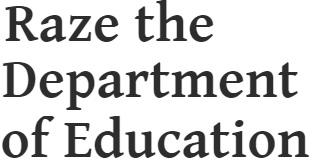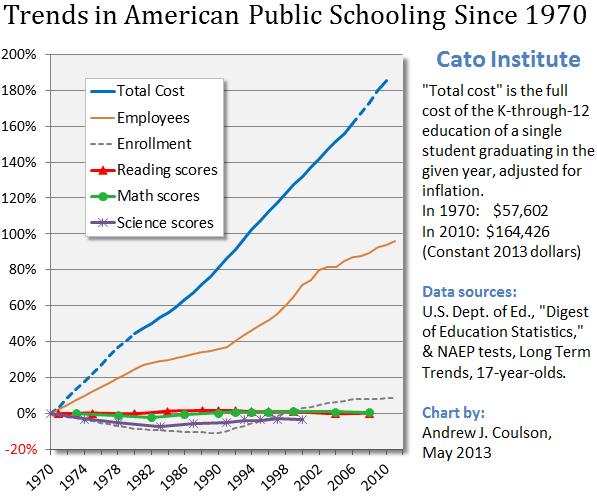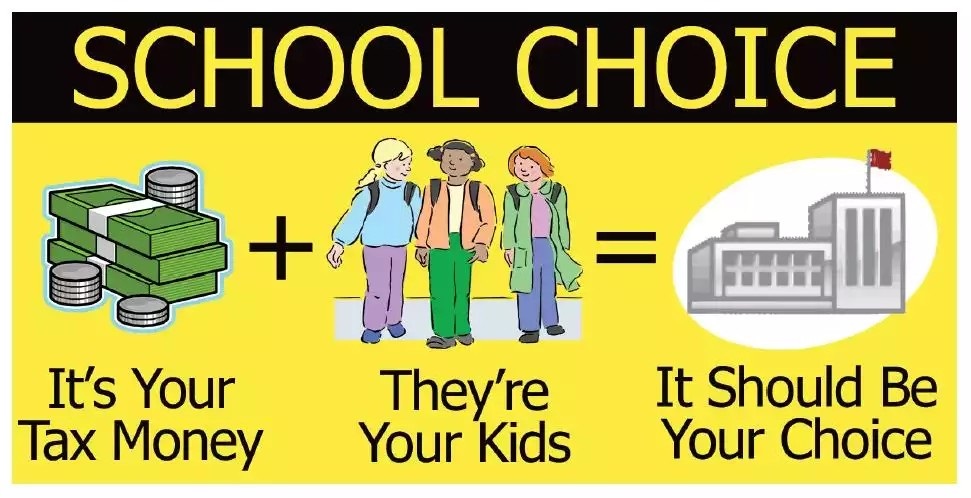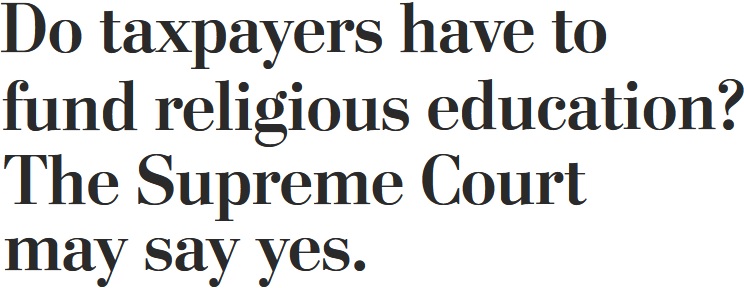—-
Tweeting the Obvious: The Department of Education Has a Failing Grade
I’ve already shared a “Tweet of the Year” for 2022, as well the “Most Enjoyable Tweet” of the year.
I’m going to call this the “Most Obvious Revelation Tweet” since it reaches a should-have-been-immediately-clear conclusion that the Department of Education is a net negative for the United States.
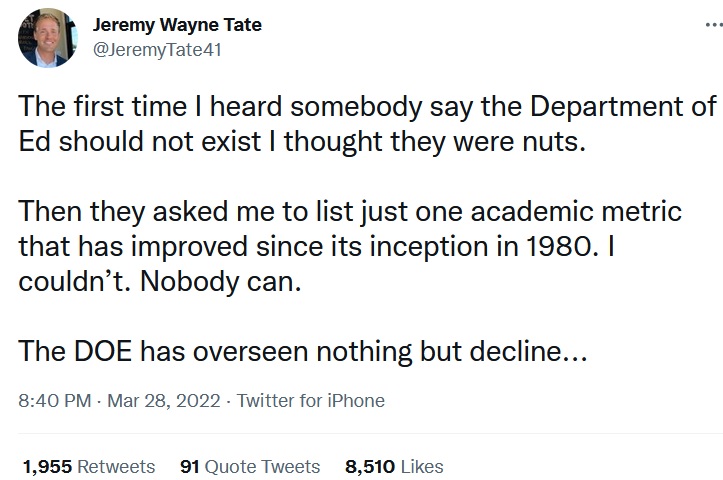
I’ve already provided my two cents on why the Department of Education should be eliminated.
So let’s look at what others have said.
In a column for National Review, Charles Cooke says it’s time for the bureaucracy to be retired.
In our constitutional order, education is the preserve of the states, and it ought to be the preserve of the states — not only because educational institutions work best when they are close to their benefactors and beneficiaries, but because education is power and because the centralization of power presents enticements that are beyond any human being’s ability to resist. …We have now seen the failure of nationalized education policy under presidents of both parties: George W. Bush’s “No Child Left Behind” was a signature of his campaign in 2000 and his pre-9/11 presidency and has been largely abandoned, as has Common Core, which started life as a “conservative” idea but was quickly sucked into the maw under President Obama. The problem, as so often, is the system itself.
And here’s some of what Neil McCluskey wrote back in 2020.
Department of Education…was basically a payoff to the National Education Association, the nation’s largest teachers union, for their 1976 support of Jimmy Carter’s presidential candidacy. …What we have gotten…One thing we do know is that total, inflation‐adjusted federal education spending, including K‑12 programs and college student aid, has risen greatly since 1980, from $115 billion to $296 billion. Meanwhile, national test scores for 17‐year‐olds have been basically flat… Federal education meddling, especially since the advent of the Department of Education, has been of questionable value at best, and a high‐dollar, bureaucratic failure at worst.
Needless to say, I agree with both of them. The current system is bad for America’s kids.
If you’re wondering why I have that view, just click here, here, here, here, and here.
By the way, it’s not just that the Department of Education has been a failure for K-12 kids. It’s also been bad news for college students.
Here are some excerpts from a 2015 column that Richard Vedder wrote for the Foundation for Economic Education.
He observes that higher education was a success story before the Department of Education was created.
The 30 years between 1950 and 1980 were the Golden Age of American higher education. The proportion of adult Americans with college degrees nearly tripled, going from 6 to 17 percent. Enrollments quintupled, going from 2.3 to 12.1 million.…This was the era in which higher education went from serving the elite and mostly well-to-do to serving many individuals from modest economic circumstance. …During this period, however, the federal role was quite modest. …College costs remained remarkably stable. Tuition fees typically rose only about one percent a year, adjusting for inflation. At the same time, high economic growth (real GDP was rising nearly four percent annually) led to incomes rising even faster, so in most years the tuition to income ratio fell. In other words, college was becoming a smaller financial burden for families.
But things took a wrong turn after a new federal bureaucracy was created. Here are some of the reasons Prof. Vedder has identified.
First, of course, education costs have soared. Tuition fees rose more than three percent a year in inflation-adjusted terms, far faster than people’s incomes. …rising federal student financial aid programs are the primary factor in this phenomenon. …Second, if anything, college has become more elitist and less accessible to low income students. The proportion of recent graduates who are from the bottom quartile of the income distribution has declined since 1970 or 1980. …Third, there has been a shocking decline in academic standards. Grade inflation is rampant. …Fourth, accreditation of colleges, overseen by the Department of Education, is expensive and ineffective. …Fifth, the federal aid programs and “college for all” propaganda promoted by the Department have led to a large proportion (probably over 40 percent) of recent graduates being underemployed… Sixth, the Department is guilty of regulatory excesses and bureaucratic blunders. …the form required of applicants for federal student aid (FAFSA) is byzantine in its complexity.
For what it’s worth, I think Rich’s first item deserves some sort of special emphasis. Maybe a couple of exclamation points to drive home the point that higher education is absurdly over-pricedtoday precisely because of government intervention to supposedly make it more affordable.
Now politicians are reacting to this mess by urging even more subsidies. Which will simply make the problem worse. Lather, rinse, repeat.
P.S. Here’s a bit of humor to compensate for the depressing news in today’s column.

My other examples of education-themed humor can be found here, here, here, and here.
P.P.S. Biden wants to reward failure with a 21 percent increase in the Department of Education’s budget.
Free To Choose 1980 – Vol. 06 What’s Wrong with Our Schools? – Full Video
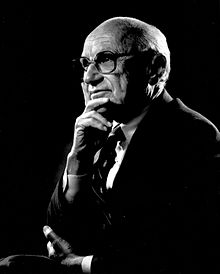
Milton Friedman chose the emphasis on school choice and school vouchers as his greatest legacy!
The Ever-Stronger Case for School Choice
If Winston Churchill was commenting on America’s governmentschools instead of the Royal Air Force, he would have said, “never have so many paid so much to achieve so little.”
Which is one of the messages in this new video from Reason.
NY Can’t Teach Kids to Read on $30,000 a Year
I won’t keep anyone in suspense.
The message of today’s column is that government schools are becoming ever-more expensive while producing ever-more dismal outcomes.
As a nation, we have two choices.
We can continue to pour more money into monopoly, government-run systems that never produce better results.
Or we can learn from the evidence and harness the benefits of competition and innovation with school choice.
Let’s look at some more data and research.
In a study published by the National Bureau of Economic Research, Dennis Epple, Richard E. Romano, and Miguel Urquiola were largely agnostic on the desirability of choice.
But their research included some very favorable analysis.
We review the theoretical, computational, and empirical research on school vouchers, with a focus on the latter. …multiple positive findings support continued exploration. …for some subgroups or outcomes, vouchers can have a substantial positive effect on those who use them. …Evidence on both small scale and large scale programs suggests that competition induced by vouchers leads public schools to improve.… The most robust finding is that voucher threats induce public schools to improve. …In addition, recent evidence from small-scale experiments in the United States finds substantial gains in years of school for recipients… More encouraging results on the effect of small-scale programs come from developing countries. …interesting evidence comes from India. While vouchers there delivered modest test-score gains, they did so at one-third the cost per student of public schools. …In the case of Sweden’s large-scale voucher program, …recent work features evidence of significant gains… Recent research also tends to support the finding that voucher competition has improved the performance of public schools.
Since I’ve written about choice programs in nations such as Canada, Sweden, Chile, and the Netherlands, I’m glad the study mentioned some of the international evidence.
Moreover, I’ve also noted that proponents of school choice have been gaining ground.
Francis Suarez, the Mayor Miami, wants more progress. A National Review article he co-authored with Corey DeAngelis makes the case for expanded options.
School choice is the civil-rights issue of the 21st century. Choosing the right school opens opportunity, it shapes success, it prevents failure, and it unleashes economic opportunity. …We believe the best way to improve our schools and invest in our future is to expand parent-driven school choice. …Miami has always led on school choice. In 1996, T. Willard Fair, the president of the Urban League of Greater Miami, partnered with Governor Jeb Bush to start Florida’s first charter school in Miami’s Liberty City neighborhood.…Since then, Miami-Dade County has launched 140 charter schools, serving more than 70,000 students, and more than 440 private schools that serve tens of thousands of students with school-choice scholarships. Miami has done well, but now we need to do better. …Moreover, the students who benefit from increased school-choice options are overwhelmingly from historically discriminated-against communities. In a 2019 study, the Urban Institute found students using the Florida Tax Credit Scholarship for lower-income families — 24,502 students in Miami-Dade used them last year — are far more likely than their public-school peers to enroll in colleges and earn bachelor’s degrees. And a 2020 study published by the National Bureau for Economic Research found that, as that same program grew, students in the district schools most affected by competition saw higher test scores.
The moral of the story is that school choice is a win-win for taxpayers and students.
Now let’s shift to the politics of school choice.
That normally means focusing on the baleful role of teacher unions, which place their personal self interest above student outcomes.
But there’s also the red-vs.-blue dynamic. In a report for the American Enterprise Institute, Jay Greene and Lindsey Burke analyze some of the challenges of trying to enact bipartisan choice legislation.
…in their quest for broader support, choice proponents have conceded to Democrats’ policy demands that ultimately weaken the options available to families: limited student eligibility, heavy-handed standardized tests and regulations, caps on scholarship amounts and student participation, and admissions regulations. Not only has that approach weakened many school choice programs, but it doesn’t appear to have actually won Democratic policymakers’ support. It may have even alienated Republican policymakers who were on the fence about supporting school choice.…Any Democratic support has been for modest or heavily regulated programs, such as the voucher program in Louisiana. The Louisiana voucher program suffers under a mountain of regulations that has discouraged private schools from participating, so much so that only one-third of the state’s private schools will accept the vouchers. …What does this all mean for private school choice proponents? It means supporters should not be afraid to make what is likely our most compelling case: that education freedom is fundamentally about enabling parents to choose learning environments that align with their values. …choice proponents should embrace and be vocal about school choice allowing families an escape hatch from government schools pushing an agenda that runs counter to their values. In other words, choice proponents should be unafraid to appeal to Republicans. …proponents have not made the cultural case for choice to the Republican base, for fear of losing Democratic legislative allies, who, it turns out, weren’t really there to begin with.
I’m a policy wonk rather than political pundit, so my only comment is that proponents shouldn’t give up on bipartisanship.
There’s new legislation in Georgia to enable choice and it has several Democratic cosponsors. If enacted, this could be even bigger news than last-year’s victory in West Virginia.
And I’ve already lauded the powerful words of Justin Wayne, a Democratic member of Nebraska’s legislature.
Speaking of politics, another complication is that charter schools (a type of choice in the government system) may undermine private schools.
Christopher Bedford explains this problem in an article for the Federalist.
Search the Lehigh Valley papers and you’ll find Catholic school after Catholic school closing down. In March 2018, Our Lady Help of Christians in Allentown closed its doors. In June 2020, Sacred Heart School in Bath and St. Francis Academy in Bally shut down. And last May, Trinity Academy in Shenandoah became the latest victim. …Charter schools are booming in Pennsylvania. …enrollment at charters rose by 25,000 last year; about 10 percent of all children in the state are enrolled in them. There are at least 14 charter schools in the Lehigh Valley region so far. …Often, in fact, the arrival of a charter is the death knell for a parochial school. In New York state, a 2012 study found that for every charter school that opened, a parochial school closed. …This is the kind of mutilated, self-defeating “victory” we see on the right far too often. Democratic teachers unions were weakened, and public school bureaucrats faced some small level of competition. …But in the big picture, parents and their children are still at the mercy of a government bureaucracy… Still, for a lot of parents, the choice is simple: They know public schools are poisonous, and now they have an alternative that doesn’t cost them a dime in tuition. And so, charter schools are booming, while parochial schools are slowly withering and dying.
This creates a quandary.
Charter schools are better than regular government schools.
But it would be a Pyrrhic Victory if the expansion of such schools undermines the vitality of private schools.
P.S. Many rich folks on the left believe in private schools, but only for their own kids.
P.P.S. There’s also evidence that school choice is better for children’s mental health since it’s associated with lower suicide rates. That’s a nice fringe benefit, much like the data on school choice and jobs.
P.P.P.S. Getting rid of the Department of Education would be a good idea, but the battle for school choice is largely won and lost on the state and local level.
Educational Choice, the Supreme Court, and a Level Playing Field for Religious Schools
The case for school choice is very straightforward.
- Monopoly government school systems cost a lot of moneyand do a bad job.The interests of the education bureaucracy rank higherthan the educational needs of kids. Poor families are especially disadvantaged.
- School choice puts parents in charge. Lots of evidence, including from overseas, shows choice improves educational outcomes. And private schools cost less, so taxpayers also win.
The good news is that there was a lot of pro-choice reform in 2021.
West Virginia adopted a statewide system that is based on parental choice. And many other states expanded choice-based programs.
But 2022 may be a good year as well. That’s because the Supreme Court is considering whether to strike down state laws that restrict choice by discriminating against religious schools.
Michael Bindas of the Institute for Justice and Walter Womack of the Southern Christian Leadership Conference make the case for a level playing field in a column for the New York Times.
In 2002, the Supreme Court held that the Constitution allows school choice programs to include schools that provide religious instruction, so long as the voucher program also offers secular options. The question now before the court is whether a state may nevertheless exclude schools that provide religious instruction. The case, Carson v. Makin, …concerns Maine’s tuition assistance program. In that large and sparsely populated state, over half of the school districts have no public high schools. If a student lives in such a district, and it does not contract with another high school to educate its students, then the district must pay tuition for the student to attend the school of her or his parents’ choice. …But one type of school is off limits: a school that provides religious instruction. That may seem unconstitutional, and we argue that it is. Only last year, the Supreme Court, citing the free exercise clause of the Constitution, held that states cannot bar students in a school choice program from selecting religious schools when it allows them to choose other private schools. …The outcome will be enormously consequential for families in public schools that are failing them and will go a long way toward determining whether the most disadvantaged families can exercise the same control over the education of their children as wealthier citizens.
The Wall Street Journal editorialized on this issue earlier this week.
Maine has one of the country’s oldest educational choice systems, a tuition program for students who live in areas that don’t run schools of their own. Instead these families get to pick a school, and public funds go toward enrollment. Religious schools are excluded, however, and on Wednesday the Supreme Court will hear from parents who have closely read the First Amendment.…Maine argues it isn’t denying funds based on the religious “status” of any school… The state claims, rather, that it is merely refusing to allocate money for a “religious use,” specifically, “an education designed to proselytize and inculcate children with a particular faith.” In practice, this distinction between “status” and “use” falls apart. Think about it: Maine is happy to fund tuition at an evangelical school, as long as nothing evangelical is taught. Hmmm. …A state can’t subsidize tuition only for private schools with government-approved values, and trying to define the product as “secular education” gives away the game. …America’s Founders knew what they were doing when they wrote the First Amendment to protect religious “free exercise.”
What does the other side say?
Rachel Laser, head of Americans United for Separation of Church and State, doesn’t want religious schools to be treated equally under school choice programs.
Here’s some of her column in the Washington Post.
…two sets of parents in Maine claim that the Constitution’s promise of religious freedom actually requires the state to fund religious education at private schools with taxpayer dollars — as a substitute for public education. This interpretation flips the meaning of religious freedom on its head and threatens both true religious freedom and public education.…The problem here is even bigger than public funds paying for praying, as wrong as that is. Unlike public schools, private religious schools often do not honor civil rights protections, especially for LGBTQ people, women, students with disabilities, religious minorities and the nonreligious. …If the court were to agree with the parents, it would also be rejecting the will of three-quarters of the states, which long ago enacted clauses in their state constitutions and passed statutes specifically prohibiting public funding of religious education. …It is up to parents and religious communities to educate their children in their faith. Publicly funded schools should never serve that purpose.
These arguments are not persuasive.
The fact that many state constitutions include so-called Blaine amendments actually undermines her argument since those provisions were motivated by a desire to discriminate against parochial schools that provided education to Catholic immigrants.
And it’s definitely not clear why school choice shouldn’t include religious schools that follow religious teachings, unless she also wants to argue that student grants and loans shouldn’t go to students at Notre Dame, Brigham Young, Liberty, and other religiously affiliated colleges.
The good news is that Ms. Laser’s arguments don’t seem to be winning. Based on this report from yesterday’s Washington Post, authored by Robert Barnes, there are reasons to believe the Justices will make the right decision.
Conservatives on the Supreme Court seemed…critical of a Maine tuition program that does not allow public funds to go to schools that promote religious instruction. The case involves an unusual program in a small state that affects only a few thousand students. But it could have greater implications… The oral argument went on for nearly two hours and featured an array of hypotheticals. …But the session ended as most suspected it would, with the three liberal justices expressing support for Maine and the six conservatives skeptical that it protected religious parents from unconstitutional discrimination.
I can’t resist sharing this additional excerpt about President Biden deciding to side with teacher unions instead of students.
The Justice Department switched its position in the case after President Biden was inaugurated and now supports Maine.
But let’s not dwell on Biden’s hackery (especially since that’s a common affliction on the left).
Instead, let’s close with some uplifting thoughts about what might happen if we get a good decision from the Supreme Court when decisions are announced next year.
Maybe I’m overly optimistic, but I think we’re getting close to a tipping point. As more and more states and communities shift to choice, we will have more and more evidence that it’s a win-win for both families and taxpayers.
Which will lead to more choice programs, which will produce more helpful data.
Lather, rinse, repeat. No wonder the (hypocritical) teacher unionsare so desperate to stop progress.
P.S. There’s strong evidence for school choice from nations such as Sweden, Chile, and the Netherlands.
Free To Choose 1980 – Vol. 06 What’s Wrong with Our Schools? – Full Video
https://youtu.be/tA9jALkw9_Q
Why Milton Friedman Saw School Choice as a First Step, Not a Final One
On his birthday, let’s celebrate Milton Friedman’s vision of enabling parents, not government, to be in control of a child’s education.
Wednesday, July 31, 2019


Kerry McDonald
EducationMilton FriedmanSchool ChoiceSchooling
Libertarians and others are often torn about school choice. They may wish to see the government schooling monopoly weakened, but they may resist supporting choice mechanisms, like vouchers and education savings accounts, because they don’t go far enough. Indeed, most current choice programs continue to rely on taxpayer funding of education and don’t address the underlying compulsory nature of elementary and secondary schooling.
Skeptics may also have legitimate fears that taxpayer-funded education choice programs will lead to over-regulation of previously independent and parochial schooling options, making all schooling mirror compulsory mass schooling, with no substantive variation.
Friedman Challenged Compulsory Schooling Laws
Milton Friedman had these same concerns. The Nobel prize-winning economist is widely considered to be the one to popularize the idea of vouchers and school choice beginning with his 1955 paper, “The Role of Government in Education.” His vision continues to be realized through the important work of EdChoice, formerly the Friedman Foundation for Education Choice, that Friedman and his economist wife, Rose, founded in 1996.
July 31 is Milton Friedman’s birthday. He died in 2006 at the age of 94, but his ideas continue to have an impact, particularly in education policy.
Friedman saw vouchers and other choice programs as half-measures. He recognized the larger problems of taxpayer funding and compulsion, but saw vouchers as an important starting point in allowing parents to regain control of their children’s education. In their popular book, Free To Choose, first published in 1980, the Friedmans wrote:
We regard the voucher plan as a partial solution because it affects neither the financing of schooling nor the compulsory attendance laws. We favor going much farther. (p.161)
They continued:
The compulsory attendance laws are the justification for government control over the standards of private schools. But it is far from clear that there is any justification for the compulsory attendance laws themselves. (p. 162)
The Friedmans admitted that their “own views on this have changed over time,” as they realized that “compulsory attendance at schools is not necessary to achieve that minimum standard of literacy and knowledge,” and that “schooling was well-nigh universal in the United States before either compulsory attendance or government financing of schooling existed. Like most laws, compulsory attendance laws have costs as well as benefits. We no longer believe the benefits justify the costs.” (pp. 162-3)
Still, they felt that vouchers would be the essential starting point toward chipping away at monopoly mass schooling by putting parents back in charge. School choice, in other words, would be a necessary but not sufficient policy approach toward addressing the underlying issue of government control of education.
Vouchers as a First Step
In their book, the Friedmans presented the potential outcomes of their proposed voucher plan, which would give parents access to some or all of the average per-pupil expenditures of a child enrolled in public school. They believed that vouchers would help create a more competitive education market, encouraging education entrepreneurship. They felt that parents would be more empowered with greater control over their children’s education and have a stronger desire to contribute some of their own money toward education. They asserted that in many places “the public school has fostered residential stratification, by tying the kind and cost of schooling to residential location” and suggested that voucher programs would lead to increased integration and heterogeneity. (pp. 166-7)
To the critics who said, and still say, that school choice programs would destroy the public schools, the Friedmans replied that these critics fail to
explain why, if the public school system is doing such a splendid job, it needs to fear competition from nongovernmental, competitive schools or, if it isn’t, why anyone should object to its “destruction.” (p. 170)
What I appreciate most about the Friedmans discussion of vouchers and the promise of school choice is their unrelenting support of parents. They believed that parents, not government bureaucrats and intellectuals, know what is best for their children’s education and well-being and are fully capable of choosing wisely for their children—when they have the opportunity to do so.
They wrote:
Parents generally have both greater interest in their children’s schooling and more intimate knowledge of their capacities and needs than anyone else. Social reformers, and educational reformers in particular, often self-righteously take for granted that parents, especially those who are poor and have little education themselves, have little interest in their children’s education and no competence to choose for them. That is a gratuitous insult. Such parents have frequently had limited opportunity to choose. However, U.S. history has demonstrated that, given the opportunity, they have often been willing to sacrifice a great deal, and have done so wisely, for their children’s welfare. (p. 160).
Sign-Up: Receive Kerry’s Weekly Parenting and Education Newsletter!
Voucher Programs Today
Today, school voucher programs exist in 15 states plus the District of Columbia. These programs have consistently shown that when parents are given the choice to opt-out of an assigned district school, many will take advantage of the opportunity. In Washington, D.C., low-income parents who win a voucher lottery send their children to private schools.
The most recent three-year federal evaluationof voucher program participants found that while student academic achievement was comparable to achievement for non-voucher students remaining in public schools, there were statistically significant improvements in other important areas. For instance, voucher participants had lower rates of chronic absenteeism than the control groups, as well as higher student satisfaction scores. There were also tremendous cost-savings.
In Wisconsin, the Milwaukee Parental Choice Program has served over 28,000 low-income students attending 129 participating private schools.
According to Corey DeAngelis, Director of School Choice at the Reason Foundation and a prolific researcher on the topic, the recent analysis of the D.C. voucher program “reveals that private schools produce the same academic outcomes for only a third of the cost of the public schools. In other words, school choice is a great investment.”
In Wisconsin, the Milwaukee Parental Choice Program was created in 1990 and is the nation’s oldest voucher program. It currently serves over 28,000 low-income students attending 129 participating private schools. Like the D.C. voucher program, data on test scores of Milwaukee voucher students show similar results to public school students, but non-academic results are promising.
Increased Access and Decreased Crime
Recent research found voucher recipients had lower crime rates and lower incidences of unplanned pregnancies in young adulthood. On his birthday, let’s celebrate Milton Friedman’s vision of enabling parents, not government, to be in control of a child’s education.
According to Howard Fuller, an education professor at Marquette University, founder of the Black Alliance for Educational Options, and one of the developers of the Milwaukee voucher program, the key is parent empowerment—particularly for low-income minority families.
In an interview with NPR, Fuller said: “What I’m saying to you is that there are thousands of black children whose lives are much better today because of the Milwaukee parental choice program,” he says.
“They were able to access better schools than they would have without a voucher.”
Putting parents back in charge of their child’s education through school choice measures was Milton Friedman’s goal. It was not his ultimate goal, as it would not fully address the funding and compulsion components of government schooling; but it was, and remains, an important first step. As the Friedmans wrote in Free To Choose:
The strong American tradition of voluntary action has provided many excellent examples that demonstrate what can be done when parents have greater choice. (p. 159).
On his birthday, let’s celebrate Milton Friedman’s vision of enabling parents, not government, to be in control of a child’s education.

Related posts:

“Friedman Friday” (“Free to Choose” episode 1 – Power of the Market. part 7 of 7)
Michael Harrington: If you don’t have the expertise, the knowledge technology today, you’re out of the debate. And I think that we have to democratize information and government as well as the economy and society. FRIEDMAN: I am sorry to say Michael Harrington’s solution is not a solution to it. He wants minority rule, I […] By Everette Hatcher III | Posted in Current Events, Milton Friedman | Edit | Comments (0)
“Friedman Friday” (“Free to Choose” episode 1 – Power of the Market. part 6 of 7)
PETERSON: Well, let me ask you how you would cope with this problem, Dr. Friedman. The people decided that they wanted cool air, and there was tremendous need, and so we built a huge industry, the air conditioning industry, hundreds of thousands of jobs, tremendous earnings opportunities and nearly all of us now have air […] By Everette Hatcher III | Posted in Current Events, Milton Friedman | Edit | Comments (0)
“Friedman Friday” (“Free to Choose” episode 1 – Power of the Market. part 5 of 7)
Part 5 Milton Friedman: I do not believe it’s proper to put the situation in terms of industrialist versus government. On the contrary, one of the reasons why I am in favor of less government is because when you have more government industrialists take it over, and the two together form a coalition against the ordinary […] By Everette Hatcher III | Posted in Current Events, Milton Friedman | Edit | Comments (0)
“Friedman Friday” (“Free to Choose” episode 1 – Power of the Market. part 4 of 7)
The fundamental principal of the free society is voluntary cooperation. The economic market, buying and selling, is one example. But it’s only one example. Voluntary cooperation is far broader than that. To take an example that at first sight seems about as far away as you can get __ the language we speak; the words […] By Everette Hatcher III | Posted in Current Events, Milton Friedman | Edit | Comments (0)
“Friedman Friday” (“Free to Choose” episode 1 – Power of the Market. part 3 of 7)
_________________________ Pt3 Nowadays there’s a considerable amount of traffic at this border. People cross a little more freely than they use to. Many people from Hong Kong trade in China and the market has helped bring the two countries closer together, but the barriers between them are still very real. On this side […] By Everette Hatcher III | Posted in Current Events, Milton Friedman | Edit | Comments (0)
“Friedman Friday” (“Free to Choose” episode 1 – Power of the Market. part 2 of 7)
Aside from its harbor, the only other important resource of Hong Kong is people __ over 4_ million of them. Like America a century ago, Hong Kong in the past few decades has been a haven for people who sought the freedom to make the most of their own abilities. Many of them are […] By Everette Hatcher III | Posted in Current Events, Milton Friedman | Edit | Comments (0)
“Friedman Friday” (“Free to Choose” episode 1 – Power of the Market. part 1of 7)
“FREE TO CHOOSE” 1: The Power of the Market (Milton Friedman) Free to Choose ^ | 1980 | Milton Friedman Posted on Monday, July 17, 2006 4:20:46 PM by Choose Ye This Day FREE TO CHOOSE: The Power of the Market Friedman: Once all of this was a swamp, covered with forest. The Canarce Indians […]
Milton Friedman The Power of the Market 1-5
Debate on Milton Friedman’s cure for inflation
If you would like to see the first three episodes on inflation in Milton Friedman’s film series “Free to Choose” then go to a previous post I did. Ep. 9 – How to Cure Inflation [4/7]. Milton Friedman’s Free to Choose (1980) Uploaded by investbligurucom on Jun 16, 2010 While many people have a fairly […]
By Everette Hatcher III | Also posted in Current Events | Tagged dr friedman, expansion history, income tax brackets, political courage, www youtube | Edit | Comments (0)
“Friedman Friday” Milton Friedman believed in liberty (Interview by Charlie Rose of Milton Friedman part 1)
Charlie Rose interview of Milton Friedman My favorite economist: Milton Friedman : A Great Champion of Liberty by V. Sundaram Milton Friedman, the Nobel Prize-winning economist who advocated an unfettered free market and had the ear of three US Presidents – Nixon, Ford and Reagan – died last Thursday (16 November, 2006 ) in San Francisco […] By Everette Hatcher III | Posted in Milton Friedman | Edit | Comments (0)
What were the main proposals of Milton Friedman?
Stearns Speaks on House Floor in Support of Balanced Budget Amendment Uploaded by RepCliffStearns on Nov 18, 2011 Speaking on House floor in support of Balanced Budget Resolution, 11/18/2011 ___________ Below are some of the main proposals of Milton Friedman. I highly respected his work. David J. Theroux said this about Milton Friedman’s view concerning […] By Everette Hatcher III | Posted in Milton Friedman | Edit | Comments (0)
“Friedman Friday,” EPISODE “The Failure of Socialism” of Free to Choose in 1990 by Milton Friedman (Part 1)
Milton Friedman: Free To Choose – The Failure Of Socialism With Ronald Reagan (Full) Published on Mar 19, 2012 by NoNationalityNeeded Milton Friedman’s writings affected me greatly when I first discovered them and I wanted to share with you. We must not head down the path of socialism like Greece has done. Abstract: Ronald Reagan […] By Everette Hatcher III | Posted in Milton Friedman, President Obama | Edit | Comments (1)
Defending Milton Friedman
What a great defense of Milton Friedman!!!! Defaming Milton Friedman by Johan Norberg This article appeared in Reason Online on September 26, 2008 PRINT PAGE CITE THIS Sans Serif Serif Share with your friends: ShareThis In the future, if you tell a student or a journalist that you favor free markets and limited government, there is […]

